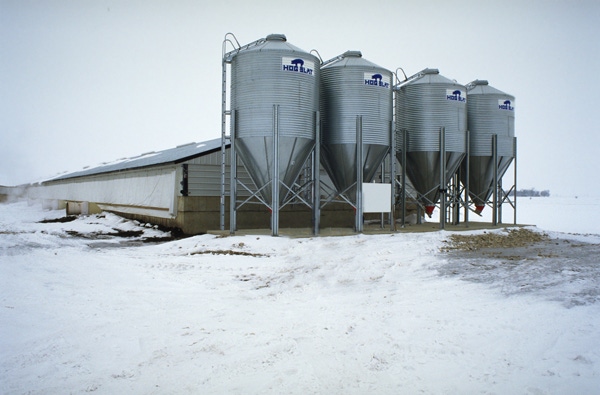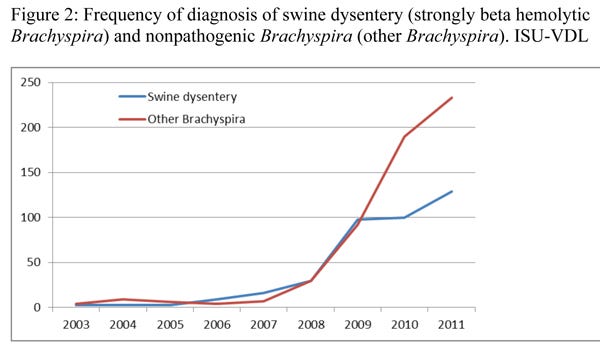Most of the infectious causes of diarrhea in pigs are commonly present in herds but only occasionally expressed. These “endemic” diseases include rotaviruses, E. coli, Isospora (coccidiosis), salmonella and Lawsonia intracellularis (ileitis).
December 3, 2012

Most of the infectious causes of diarrhea in pigs are commonly present in herds but only occasionally expressed. These “endemic” diseases include rotaviruses, E. coli, Isospora (coccidiosis), salmonella and Lawsonia intracellularis (ileitis).
For these agents, environmental stressors (e.g. cold, wet, drafts) and overall hygiene have a large impact on disease expression. “Internal biosecurity” aims to minimize transmission of these agents between crates, pens, barns or sites within a system.
“External biosecurity” is a different concept which aims to keep out disease agents not currently present on the farm. External biosecurity is defined by the processes and procedures put in place to prevent introduction of “new” disease agents or strains to a farm or system. Most producers and veterinarians focus mostly on preventing new introductions of porcine reproductive and respiratory syndrome to sow herds in their external biosecurity plans.
But there are a several other enteric diseases that farms can and should avoid. External biosecurity is particularly important in hog-dense areas to prevent introduction of diarrhea-producing diseases such as TGE, brachyspira or new strains of salmonella.
TGE: Transmissible gastroenteritis
Each and every year for at least the last 60 years, the number of cases of TGE increase in late fall and early winter (Figure 1). Despite the mild weather, the Iowa State University Veterinary Diagnostic Laboratory (ISU-VDL) is seeing a similar rise in late 2012.

In recent years, most TGE cases occurred in grow-finish or wean-to-finish barns where biosecurity is harder to consistently implement in cold weather. The cold-hardy TGE virus is spread by feces or items (fomites) contaminated by feces from infected pigs. The virus can survive for weeks in cold, frozen environments. One of the more common sources of infection is the “back-door” introduction by transportation vehicles, particularly market trucks, that are not disinfected between loads. The virus contaminates trucks, chutes and surfaces to serve as a source of infection for pigs on the site or new pigs arriving at the site. A new introduction of TGE will usually result in clinical diarrhea within a few days. Feces collected from pigs with acute phase of diarrhea and submitted for laboratory testing will confirm the diagnosis.
If you are convinced that TGE is a threat, then a fair question might be: “What are some other agents that can enter via the back-door?” Since virtually all enteric diseases are transmitted in feces, the answer is “many.” Those most likely to be “new” to a farm are Brachyspira and Salmonella.
Brachyspira (swine dysentery, bloody scours)
Since 2006, the number of cases of swine dysentery presented to ISU VDL have increased substantially (Figure 2). The cause of swine dysentery is members of the genus Brachyspira that are strongly beta-hemolytic on blood agar, currently known as either B. hyodysenteriae or B. hampsonii. There are also species of Brachyspira that are not strongly beta-hemolytic that are inherently less virulent or considered commensals.

Swine dysentery is a very expensive disease that compromises growth, feed efficiency and often requires expensive, nearly continuous, medication to suppress the disease. Asymptomatic infected pigs can carry and shed Brachyspira for prolonged periods.
The risk of introduction of this disease is year-round; however, Brachyspira do persist longer in cool environments with even greater risk of introduction in winter months when fecal contamination is more likely to be overlooked in transport vehicles. Feces-contaminated slaughter collection points, trucks, and equipment again become an important source of infection to other pigs and facilities.
Unlike TGE, however, the introduction of swine dysentery into a herd or site may not become apparent for weeks or months after introduction. It is wise to get diagnostic assistance whenever there is blood and mucus in feces so that accurate diagnosis and rapid elimination can be implemented. Swine dysentery is definitely a disease to avoid.
Salmonella Infections and Disease
Salmonella is a fairly common infection in swine herds; however, with over 2,500 different serotypes, not all salmonella infections are equal. Some serotypes are more virulent, or when newly introduced to a swine herd, can cause clinical diarrhea. Data from the ISU VDL suggests the frequency of diagnosis of salmonellosis to be steady or increasing (Figure 3). Salmonellosis tends to be more severe in young pigs (Figure 4) for many reasons, including immature intestinal function, changing gut microflora and concurrent diseases. Susceptibility is increased with higher doses and with environmental stressors, emphasizing the need for both hygiene and husbandry on the farm.


The sources of infection include other animals or contaminated feed, but similar to Brachyspira and TGE, the source can also be from inadvertent introduction of feces-contaminated fomites. “Back-door” introductions of salmonella can spread quickly upstream to younger pigs.
Summary:
1. Execution of external biosecurity practices are very important in winter months.
2. Diseases such as TGE, Brachyspira and Salmonella often use the “back door” to get into a herd.
3. Extra vigilance for sources of fecal contamination, especially with transport vehicles and manure handling equipment – or anything that can be contaminated with pig feces, is particularly important in the winter months.
You May Also Like



